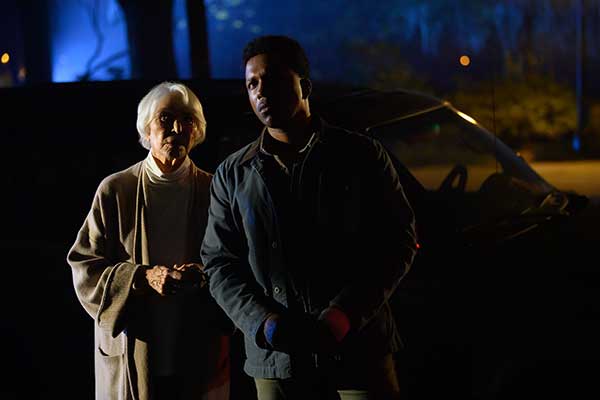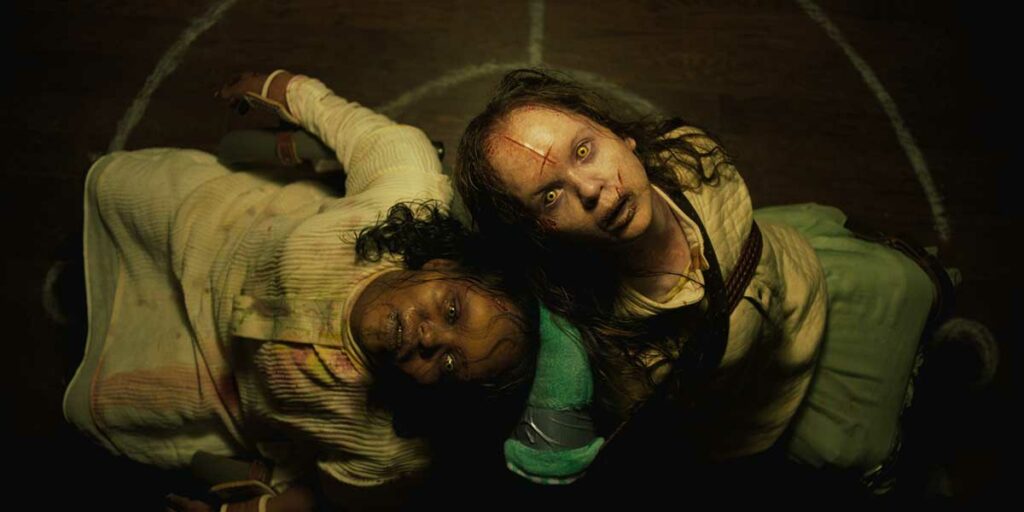David Gordon Green’s The Exorcist: Believer fundamentally misunderstands what made the original film (and book) stand the test of time as one of the most influential pieces of horror storytelling ever crafted.
*This review of The Exorcist: Believer was written during the 2023 SAG-AFTRA strike. Without the labor of the actors currently on strike, the movie being covered here wouldn’t exist.*
The core of William Peter Blatty’s “The Exorcist” isn’t the possession of Regan MacNeil (Linda Blair), but the two priests, Father Damian Karras (Jason Miller) and Lankester Merrin (Max von Sydow), who have their allegiance to God tested when they come face-to-face with the devil incarnate. Karras is going through a crisis of faith, while Merrin already feels a demonic presence looming as he discovers the statue of the demon. The late filmmaker William Friedkin understood what made The Exorcist so unsettling as an examination of faith and our belief in a higher power when he adapted Blatty’s book to a motion picture in 1973, which is historically-known as the scariest film ever made. Yes, some of the imagery in the film is terrifying, but its thematic subtext is even richer than the direct terror the audience is inflicted upon on screen.
John Boorman’s Exorcist II: The Heretic was never able to match Friedkin’s visionary film, as it focused on the wrong aspect of the original film. Only Blatty himself got to examine a crisis of faith further in his own Exorcist III (which was adapted from Blatty’s “Legion”), which is, in many cases, far more terrifying than Friedkin’s The Exorcist, even if most of it consists of people talking.
What gets under your skin is how Blatty visually represents Evil, and juxtaposes Damien Karras’ corrupted soul with the one of the Gemini Killer (Brad Dourif) in the very best match-cut in horror cinema history. I believe it so, but Morgan Creek was so dissatisfied with the original cut that they required an exorcism scene near the end of a movie, where a priest who, throughout the film, underwent a crisis of faith, is forced to reckon with something (not someone) he doesn’t want to face. Even when a studio mandates a scene that makes absolutely no shred of sense to be in, Blatty still delivered, albeit that part was far more undercooked than the rest of the film.
Time has only been nicer to Exorcist III, which has enjoyed many years of reappraisals by the horror community – a clear sign that the franchise should’ve ended there. But it wasn’t enough for Morgan Creek, who released two disastrous prequels in Exorcist: The Beginning and Dominion: Prequel to The Exorcist. The latter, directed by Paul Schrader, was the original version that was entirely reshot by Renny Harlin to amp up the action and “exorcisms.” It was, of course, far worse than Schrader’s film, which attempted to examine some of Blatty’s biblical themes, but never did it with enough depth to make an impact.
Blumhouse and David Gordon Green could have done something interesting with The Exorcist: Believer, the first part in a planned trilogy of films, which completely disregards the sequels (and prequels) that came after the 1973 film and sets it instead fifty years after the events of the original. In it, two girls, Katherine (Olivia Marcum) and Angela (Lidya Jewett), get possessed by a demon after attempting to contact Angela’s late mother, who died during the 2010 earthquakes of Haiti after her husband, Victor Fielding (Leslie Odom Jr.), chose to keep the baby instead of saving her life.

Now, Victor has no idea what to do as her daughter’s behavior gets more erratic and unpredictable by the day, while Katherine’s parents (Jennifer Nettles & Norbert Leo Butz), strongly believe in demonic possession. With no idea what to do to aid the two girls, Victor turns to Chris MacNeil (Ellen Burstyn), who has had some experience with the topic of demonic possession and wrote a book about her experience with Regan. And that’s where the movie starts to go south.
Apart from an incredibly exploitative opening scene which sees fictional characters inside a real-life tragedy with countless real human lives lost, The Exorcist: Believer’s subsequent opening moments involving Angela and Victor start out decently. Michael Simmonds’ IMAX cinematography and Tim Alverson’s sharp cuts have the almost-feel of a cinéma vérité documentary to them. The camera observes the characters in an increasingly stressful situation in a subjective and immersive point of view instead of being distanced from the action. It’s fully involved in the proceedings from beginning to end, and makes the drama surrounding Katherine and Angela’s disappearance all the more engrossing.
The sound design is also particularly well done, with Green seemingly preferring atmospheric scares instead of all-out jumpscares. That particularly amps up the sense of dread during its opening moments where we clearly see the signs of possession, but not enough to make them apparent for Victor and Katherine’s parents (until, of course, Katherine smears herself with Holy Water and shouts “The Body and the Blood” during mass, arguably the film’s most terrifying scene).
However, when Chris MacNeil appears in an extended cameo (even if the trailers made her look like she was going to have a prominent role), the film gets stuck in a downward spiral and never recovers. For once, what Green and co-screenwriter Peter Sattler do with Chris MacNeil’s arc can only be described as “blasphemous.” You have a veteran actor return (Burstyn reportedly declined to come back multiple times until a sizeable offer was made for her to say yes) in one of her most iconic roles and do nothing of interest other than spoon-feed useless exposition and insert her in a scene that not only insults the audience’s intelligence, but the character’s enduring legacy. There’s a reason why she didn’t want to come back, and the character’s appearance in the film only proves her right.
But the biggest problem in The Exorcist: Believer, which is also the main problem of The Heretic and The Beginning, is that Green never once explores the question of faith, even if the title itself is “believer.” You see, Victor doesn’t believe in God, or in any form of religion, despite her neighbor, Ann (Ann Dowd), attempting to convince him that He is real, while Katherine’s parents are heavily involved in Baptism. Exploring Victor’s non-belief in religion would not only enhance his arc, but harken back to what Blatty explored in The Exorcist books. It should be the main focal point of the film, not Angela and Katherine’s possession.
I mean, the climax sees Christianity, Baptism, Pentecostalism, and even ritualistic healing team up to exorcise the demons out of Katherine and Angela. Religion is involved in this movie, but never in a way that feels urgent or deep enough for us to care about the messaging. Green seemingly understands that religion has a big place in Blatty’s text, but doesn’t understand that it’s literally what The Exorcist is about. Not the possession, not the demon, not Chris, not Regan, but the priests. And if you don’t want your film to be about that, fine, but if you title it “Believer,” and posit Victor as a non-believer (who will eventually believe in something to save his daughter: it’s written in the sky), you’re damn sure the audience will expect some form of religious subtext as the film examines faith from all sides, one way or another. If your climax is going to be Religions: Assemble, without any messaging behind it or at least some meaning, then what’s the point?
Instead, The Exorcist: Believer seems too busy trying to cash in on some good ol’ nostalgia, by retreading scenes, lines and even characters from the original film for the audience to artificially feel something when they see Ellen Burstyn return as Chris MacNeil, only for them to want to violently storm out of the cinema when they see what Green does with her. It is a deeply toothless moviegoing experience with absolutely nothing of interest to say on faith, whether it be our belief in it or someone’s experience in attempting to approach a higher power, desperate to save a life. The ideas are introduced, but never laid out in a way that feels prescient and engaging. I have no idea if we’ll be getting two more of these, but at least it’s better than Exorcist: The Beginning, so there’s that.
The Exorcist: Believer is now available to watch globally in theaters. Read our reviews of more recent religious horror movies: Thine Ears Shall Bleed, Deliver Us, The Devil’s Bath, The Last Rite, The Pope’s Exorcist, Prey for the Devil, and Skeletons in the Closet!

